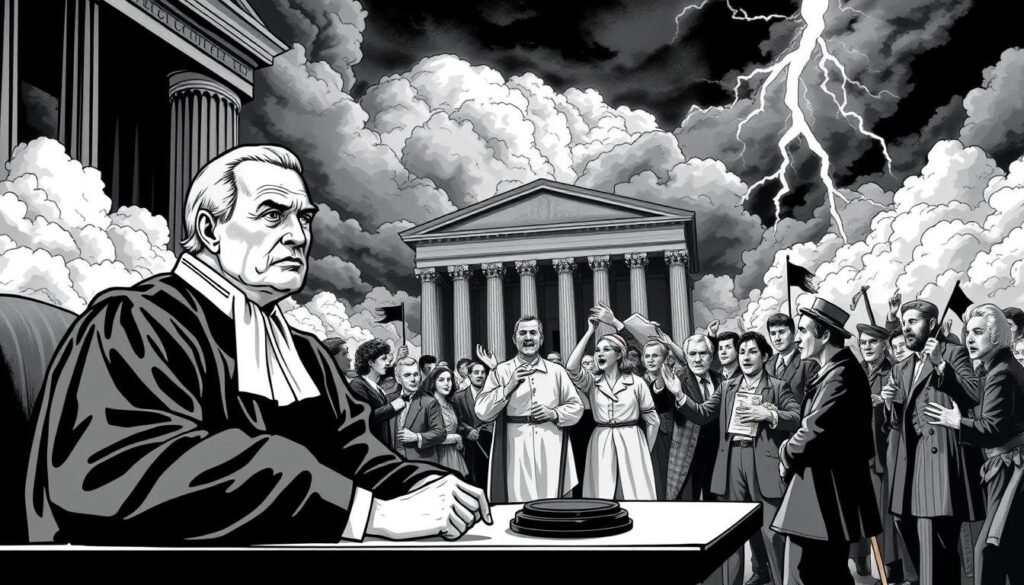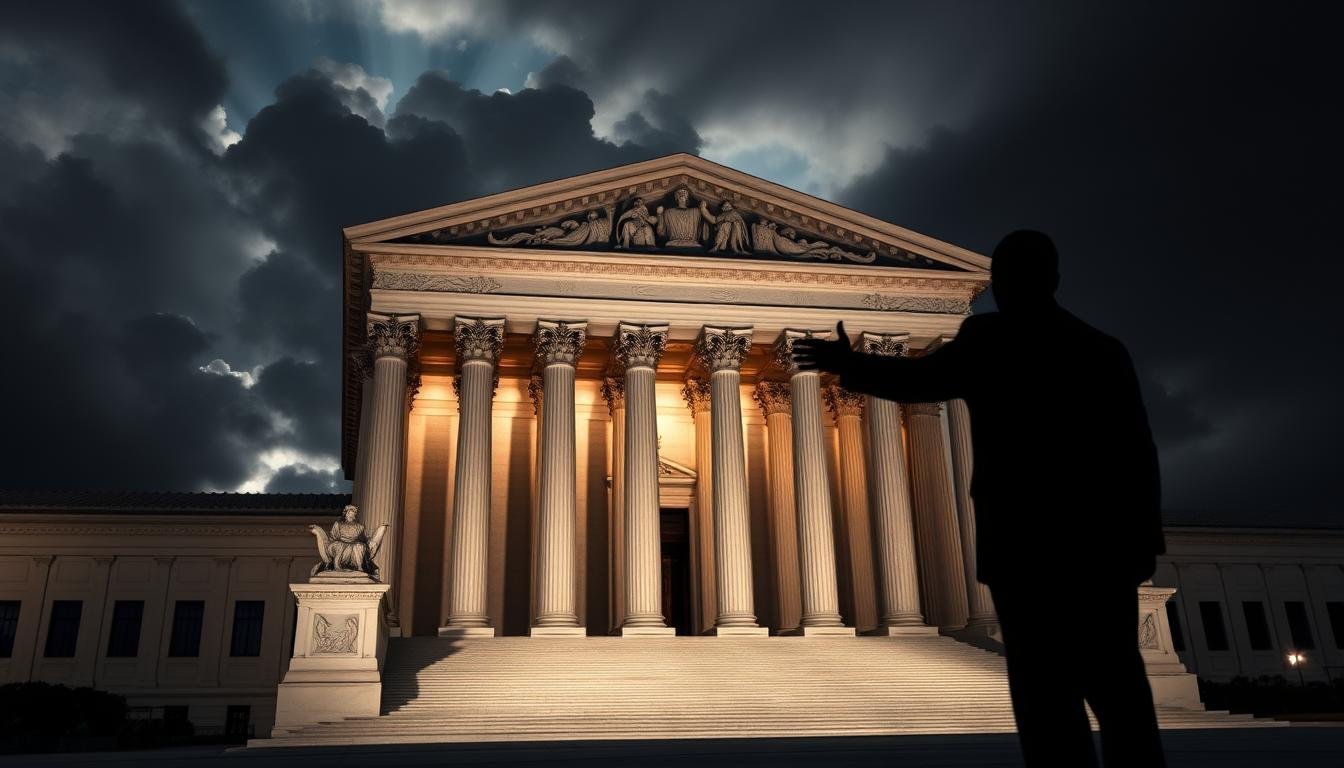Can the President Dissolve the Supreme Court? Have you ever thought about how much power the president has in the United States? Specifically, can the president dissolve the Supreme Court? This question gets to the core of constitutional law and the balance of power.
The Supreme Court is the top court in the land. It makes sure laws match the Constitution. Knowing how the president and the courts work together is key to answering this question.
In this article, we’ll dive into the Supreme Court’s role and the laws that guide it. We’ll look closely at the idea of supreme court dissolution and what it means.
Contents
- 1 The Constitutional Foundation of the Supreme Court
- 2 Understanding the Separation of Powers
- 3 Can the President Dissolve the Supreme Court?
- 4 Historical Challenges to Supreme Court Authority
- 5 Potential Constitutional Pathways for Court Reform
- 6 Conclusion: Can the President Dissolve the Supreme Court?
- 7 FAQ
- 7.1 What is the constitutional foundation of the Supreme Court?
- 7.2 Can the President unilaterally dissolve the Supreme Court?
- 7.3 What is the principle of separation of powers, and how does it relate to the Supreme Court?
- 7.4 Have there been historical challenges to the Supreme Court’s authority?
- 7.5 Are there constitutional pathways for reforming or restructuring the Supreme Court?
- 7.6 What role does the President play in shaping the Supreme Court?
The Constitutional Foundation of the Supreme Court
Studying the Supreme Court’s independence reveals a lot. The Constitution sets its authority in Article III. This shows its key role in the federal judiciary and its power to interpret constitutional law.
The Constitution gives the Supreme Court power over all cases under the Constitution and laws. This is key to understanding its judicial independence. It also lets the Supreme Court check lower court decisions, ensuring the law is followed everywhere.
Article III and the Supreme Court’s Role
Article III is crucial for the Supreme Court’s supreme court jurisdiction. It not only establishes the Supreme Court but also lets Congress create lower courts. The Supreme Court can only handle certain cases directly. For others, it reviews decisions from lower courts.
Knowing Article III well helps understand the Supreme Court’s powers. The constitutional law it provides makes the Supreme Court an equal branch of government. It can check the other branches through judicial review.
Understanding the Separation of Powers
When looking at the relationship between the executive branch and the Supreme Court, it’s key to grasp the separation of powers. This idea stops any one part of government from getting too strong.
The U.S. Constitution splits power among the legislative, executive, and judicial branches. This split is vital for keeping checks and balances. For example, the president can appoint Supreme Court justices, but the Senate must approve them. This shows how checks and balances work.
The separation of powers also means the judicial branch, led by the Supreme Court, is independent from the executive. The Constitution gives the Supreme Court judicial power, showing it’s not controlled by the president.
The Role of Checks and Balances
Checks and balances are key in the U.S. system of government. They stop any branch from misusing its power. Here’s a simple look at how checks and balances work among the three branches:
| Branch | Powers | Checks |
|---|---|---|
| Legislative | Can impeach and remove the president and Supreme Court justices | Can override presidential vetoes |
| Executive | Can veto laws passed by Congress, appoints Supreme Court justices | Can be impeached and removed by Congress |
| Judicial | Can declare laws passed by Congress and actions by the president as unconstitutional | Justices are appointed by the president and confirmed by the Senate |
Knowing these details is important for understanding the limits of presidential powers and the Supreme Court’s role.
Can the President Dissolve the Supreme Court?
Many wonder if the president can dissolve the Supreme Court. This question gets to the heart of constitutional law. The U.S. Constitution sets out the roles of the government’s three branches. Yet, it doesn’t say if the president can dissolve the Supreme Court.
The topic of presidential authority over the Supreme Court is tricky. In the past, presidents have tested their limits, sometimes against the Supreme Court’s rulings. Looking at these moments can help us understand if a president might dissolve the Supreme Court.
Let’s dive into some important points:
- The constitutional rules about the Supreme Court and the president’s power.
- Times when presidents have faced off against the Supreme Court.
- What dissolving the Supreme Court could mean for power balance and the law.
| Aspect | Constitutional Provision | Historical Precedent |
|---|---|---|
| Supreme Court Composition | Congress decides how many justices the Supreme Court has. | Congress has changed the number of justices before. |
| Presidential Authority | The president’s power comes from Article II of the Constitution. | Presidents have used their power to shape judicial choices. |
| Judicial Independence | The Constitution protects judges with lifetime jobs and salaries. | The Supreme Court has stayed independent, even with political pressure. |
The table shows key points about the president and the Supreme Court. It’s clear that the Constitution sets a framework. But history and interpretation have shaped their relationship a lot.
In summary, whether the president can dissolve the Supreme Court is still debated. It’s crucial to think about how this could affect power balance and the law in the U.S.
Historical Challenges to Supreme Court Authority
Did you know the Supreme Court has faced big challenges to its power in American history? One big example was President Franklin D. Roosevelt’s court-packing plan in the 1930s.
This plan was a response to the Supreme Court striking down New Deal laws. Roosevelt saw this as a big hurdle to his economic plans. He proposed adding up to six new justices over 70 years old. This move was seen as a direct challenge to the Court’s judicial independence.

The court-packing plan caused a lot of debate. Supporters said it was needed to update the Court. Opponents saw it as an attack on the separation of powers and the judiciary’s independence. In the end, Congress didn’t pass it, but it changed the Court’s decisions. This change is known as the “switch in time that saved nine.”
Key Historical Challenges
- President Franklin D. Roosevelt’s court-packing plan
- The Supreme Court’s handling of Reconstruction-era cases
- Controversies surrounding judicial appointments
These challenges show the ongoing fight between the executive and judicial branches. The Supreme Court has dealt with these issues while keeping its supreme court authority and judicial independence. Knowing these historical moments helps us understand future conflicts and how they are solved.
The U.S. constitutional framework has shown its strength by adapting to these challenges. Looking at the historical challenges to the Supreme Court’s authority shows its crucial and complex role in American governance.
Potential Constitutional Pathways for Court Reform
Wondering how to change the Supreme Court? The answer is through constitutional amendments and laws. Reforming the Supreme Court means understanding the legal and political rules that shape it.
Constitutional changes are a key way to reform the Supreme Court. Changing the Constitution is hard. It needs a two-thirds vote in both the House and Senate, or a call from two-thirds of state legislatures. This ensures any changes are well thought out and supported by many.
Laws passed by Congress are another way to reform. Congress can change the Court’s power or how it works. For example, Congress can decide what cases the Court can handle. Laws are easier to change than the Constitution, needing less agreement.
Thinking about court reform means looking at its effects. Consider how changes might affect the Court’s independence and its role in law. Also, think about how it will work with other government branches.
But, reforming the Court is not easy. There are political and legal obstacles. Any changes must fit with the Constitution and keep the Court’s integrity.
Conclusion: Can the President Dissolve the Supreme Court?
The question of whether the president can dissolve the Supreme Court is complex. It is deeply rooted in constitutional law and the principle of separation of powers.
The relationship between the executive and judicial branches is complex. The Constitution provides ways for change and reform. While the president can’t dissolve the Supreme Court alone, there are other ways to reform it.
Understanding presidential powers and the Supreme Court’s role is key. This knowledge helps us navigate U.S. governance’s complexities. The balance of power in the U.S. is delicate.
In reaching this conclusion, it’s clear that the interaction between government branches needs careful thought. A deep understanding of the Constitution is essential.
See Also: Were Any U.S. Presidents Born in Tennessee?
FAQ
What is the constitutional foundation of the Supreme Court?
The Supreme Court’s roots are in Article III of the U.S. Constitution. It sets up the Supreme Court and outlines its role.
Can the President unilaterally dissolve the Supreme Court?
No, the President can’t dissolve the Supreme Court alone. The Constitution gives the Supreme Court its power, showing it’s independent from the President.
What is the principle of separation of powers, and how does it relate to the Supreme Court?
The U.S. Constitution’s core idea is the separation of powers. It stops any one branch from getting too strong. This keeps the Supreme Court free from the President’s control.
Yes, there have been times when the Supreme Court faced challenges. For example, President Franklin D. Roosevelt’s court-packing plan showed the tension between the executive and judicial branches.
Are there constitutional pathways for reforming or restructuring the Supreme Court?
Yes, you can change the Supreme Court through constitutional amendments or laws. These paths offer ways to alter its structure or duties.
What role does the President play in shaping the Supreme Court?
The President has some influence over the Supreme Court. They can nominate justices, but the Senate must agree. This gives the President a say in who serves on the Court.

Hi, I am Tatum Bradford from Washington. I have a background in political science and work as a senior revenue officer. I love learning about U.S. presidents and sharing interesting facts about political history.

